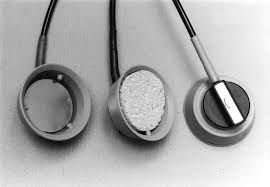The interferential current was introduced in Britain in the early 1950’s after Dr Nemec developed the concept in Vienna, and it became increasingly popular in the 1960s and 70s, particularly in Europe.
The purpose of crossing two medium frequency currents was to make use of the fact that the skin offers very little ohmic resistance to the passage of medium frequencies. Whereas ohmic resistance to the passage of direct current and low frequency currents is very high, it is reduced with medium frequencies. This meant less sensory stimulus when stimulating motor nerves to produce a muscle contraction, greater depth, and accuracy.
Foam pads were moistened to facilitate the transfer of the current across the skin and suction cups were used to keep the foam pads in place on the skin.
Interferential was found to be particularly effective for the treatment of pain. This was confirmed by a few physiotherapists in Britain who used one of the early sources of this current in the 1950s. Miss Willie, who used Interferential Therapy at Sandhurst Military Academy, was impressed with its therapeutic value and her experience in her 1969 article prompted others to try it.
Description provided by Susan Waller of United Arab Emirates
References:
Willie CD. 1969. Interferential Therapy. Physiotherapy, 55, 12.
Ganne JM. 1976. Interferential Therapy. Australian Journal of Physiotherapy, 2(3), 101-110.

